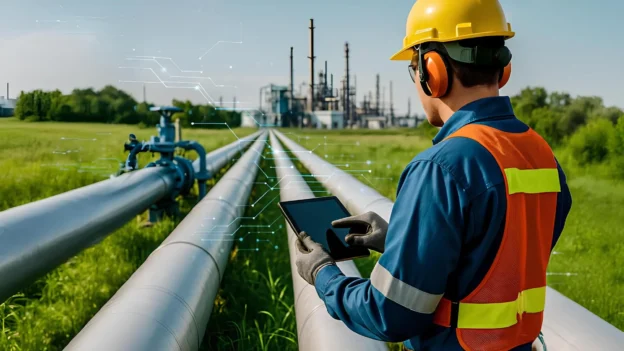In the hydrocarbon value chain, the midstream segment – responsible for transportation, storage and upstream processing – is undergoing a transformation process through the integration of digital technologies, advanced automation and sustainability-oriented solutions. This change responds to the need to improve operability, reduce losses, comply with environmental regulations and preserve the integrity of critical assets.
Digitization and real-time operational monitoring The transformation to an intelligent midstream is based on the implementation of distributed monitoring systems that operate in real time. The strategic deployment of wireless sensor networks, based on robust and energy-efficient communication protocols, allows recording parameters in pipelines, pumping stations and terminals, such as internal pressure, temperature, vibration, flow and corrosion conditions.
This data is processed locally through edge computing platforms, reducing latency and enabling immediate operational responses. Integrated with next-generation SCADA systems, perimeter analytics solutions generate intelligent alerts and predictive dashboards to anticipate deviations, detect incipient leaks or respond to transient events.
Internal inspection using instrumented tools such as smart pigging incorporates ultrasonic and magnetic flux leakage (MFL) technologies, equipped with ultrasonic or magnetic sensors, which allow mapping residual thicknesses, identifying geometric deformations and locating areas with metal loss due to corrosion. These techniques are applied in-line, without the need to interrupt product flow, and provide highresolution quantitative data for structural integrity assessment in pipelines and piping.
Predictive analytics and adaptive control applied to operational efficiency
Operational efficiency in the smart midstream context relies on advanced predictive analytics techniques based on statistical inference and machine learning algorithms. Models such as ARIMA (AutoRegressive Integrated Moving Average), Prophet and recurrent neural networks (RNN) allow to anticipate with high accuracy anomalous events, failures or deviations, based on historical patterns and dynamic variations of the system.
These models feed adaptive control systems capable of adjusting, in real time, operating variables according to demand and load conditions. The fast response time optimizes performance in pumping stations, compressors and interconnected networks, promoting a dynamic hydraulic balance that minimizes mechanical wear and tear on assets.
Operational safety is strengthened by early warning mechanisms based on dynamic thresholds and multivariate analysis. In addition, resilient, fault-tolerant architectures-including functional redundancy and backup communication channels-ensure operational continuity at strategic nodes in the face of technical events or cyber threats.
Sustainability and environmental mitigation in the smart midstream
The smart midstream incorporates advanced continuous monitoring technologies for early and accurate detection of emissions, with the aim of reducing the environmental footprint, especially in the face of fugitive methane emissions. These include tunable diode laser spectrometry (TDLAS), remote optical sensors and unmanned aerial platforms (drones) equipped with highresolution hyperspectral cameras.
Additionally, in facilities such as sour gas treatment plants, carbon capture and storage (CCS) systems are integrated to separate CO₂ and H₂S, facilitating their reinjection into geological formations. These strategies are complemented with the electrification of compressor and pumping stations with on-site renewable energy, aligning hydrocarbon transportation with the decarbonization and sustainability objectives of the energy sector.
Operational challenges and technological projections
Although digital progress in the midstream is significant, many facilities still operate with obsolete infrastructure that limits technological integration without a prior physical modernization strategy. Interoperability between legacy systems and digital platforms requires structured investments in cybersecurity, protocol standardization and regulatory compliance.
In parallel, the energy transition poses additional challenges: transporting green hydrogen, advanced biofuels and synthetic fuels requires redesigning materials, purge systems and network configurations to ensure chemical compatibility and operational integrity.
Against this backdrop, emerging technologies such as digital twins – real-time virtual replicas of physical assets – allow operations to be modeled, event responses to be validated, and personnel to be trained safely. Combined with augmented reality and perimeter artificial intelligence (edge-AI), they optimize decision making in complex environments.
In short, the intelligent midstream is no longer a futuristic concept but a strategic necessity. The integration of predictive analytics, electrification, digital inspection and data-driven management enables the industry to modernize its assets, reduce risks and align with decarbonization goals. This approach consolidates the sector as an operational pillar in the 21st century energy ecosystem.
This article was developed by specialist Mayuly Rodríguez and published as part of the fifth edition of Inspenet Brief magazine August 2025, dedicated to technical content in the energy and industrial sector.

